At this Thanksgiving time who or what are you most thankful for? Maybe it is a special book that you share with your class. Or the opportunity to gather with family and friends around a Thanksgiving feast. Or maybe it is all of the holiday football games on television. This week we share books around the theme of thankfulness and Thanksgiving. The International Reading Association Children’s Literature and Reading Special Interest Group is thankful that you read our book reviews each week. We are also thankful that you are share books with children everyday!
For more Thanksgiving ideas, be sure to check out 5 Questions With... Mike Allegra (Author of Sarah Gives Thanks) and Putting Books to Work: Judy Cox's One is a Feast for a Mouse: A Thanksgiving Tale on the Engage blog:
GRADES K-3
Bullard, Lisa. (2012). Grace’s Thanksgiving. Illus. by Katie Saunders. Minneapolis: Millbrook Press.
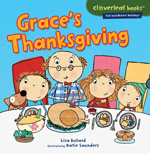 With simple text and bold illustrations filled with thankful and contented friends and families of all sorts and sizes, this short book provides an introduction to the Thanksgiving holiday and some of the family traditions associated with it. Divided into four brief sections, the book gives reasons for each of us to be grateful but also carefully points out how Thanksgiving is not a day of celebration for many Native Americans. Although the feast day is often considered a curiously American custom, the text reveals that many cultures have harvest festivals similar to our Thanksgiving.
With simple text and bold illustrations filled with thankful and contented friends and families of all sorts and sizes, this short book provides an introduction to the Thanksgiving holiday and some of the family traditions associated with it. Divided into four brief sections, the book gives reasons for each of us to be grateful but also carefully points out how Thanksgiving is not a day of celebration for many Native Americans. Although the feast day is often considered a curiously American custom, the text reveals that many cultures have harvest festivals similar to our Thanksgiving.
- Barbara A. Ward, Washington State University Pullman
Gal, Susan. (2012). Day by day. New York: Knopf/Random House.
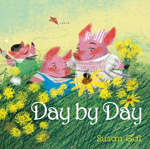 A family of pigs travels mile after mile out west to establish a new home. When they arrive at the selected spot, their work begins. They build a house and then turn it into a home. They plant their garden, meet their neighbors, celebrate in pig-“sty”le fun, harvest their crops, and share their bounty with neighbors. On each page spread, the author uses the phrases “little by little, the bird builds its nest.” In pastels and textures, the text is simple and roundly floats through this idyllic story. Young children will enjoy spotting literary pigs from other stories tucked into the illustrations. This will be an alternative way of using a story for thankfulness and sharing without the traditional Thanksgiving theme.
A family of pigs travels mile after mile out west to establish a new home. When they arrive at the selected spot, their work begins. They build a house and then turn it into a home. They plant their garden, meet their neighbors, celebrate in pig-“sty”le fun, harvest their crops, and share their bounty with neighbors. On each page spread, the author uses the phrases “little by little, the bird builds its nest.” In pastels and textures, the text is simple and roundly floats through this idyllic story. Young children will enjoy spotting literary pigs from other stories tucked into the illustrations. This will be an alternative way of using a story for thankfulness and sharing without the traditional Thanksgiving theme.
- Karen Hildebrand, Ohio Library and Reading Consultant
Gillen, Lynea. (2012). Good people everywhere. Portland, OR: Three Pebbles Press.
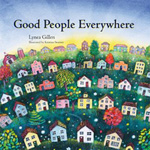 This gentle story about finding the good in people will be a great read aloud or bedtime story for our youngest readers. The author provides a positive and uplifting way to look at the people around you and see the many wonderful and helpful things people do for their friends, neighbors, or folks in need. Examples of good people doing good things include the chef that cooks for the needy, the young teen helping on the playground, or parents providing for their children. This books offers a statement about safe and nurturing environments for children to grow up within. Craft ideas at the end of the book give a hands-on activity for children to develop these same attitudes about gratitude and thankfulness. The publisher’s website offers information about the author and illustrator as well as several downloadable activities.
This gentle story about finding the good in people will be a great read aloud or bedtime story for our youngest readers. The author provides a positive and uplifting way to look at the people around you and see the many wonderful and helpful things people do for their friends, neighbors, or folks in need. Examples of good people doing good things include the chef that cooks for the needy, the young teen helping on the playground, or parents providing for their children. This books offers a statement about safe and nurturing environments for children to grow up within. Craft ideas at the end of the book give a hands-on activity for children to develop these same attitudes about gratitude and thankfulness. The publisher’s website offers information about the author and illustrator as well as several downloadable activities.
- Karen Hildebrand, Ohio Library and Reading Consultant
Landau, Elaine. (2012). What is Thanksgiving? Berkeley Heights, NJ: Enslow Elementary.
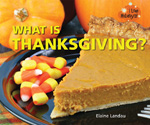 Filled with the usual historical images of the Pilgrims and Native Americans associated with this November holiday and photographs of tables heaped with food and smiling families gathered together to feast and have fun together, this simple title provides background information for the holiday and its significance. The author reminds readers to find a way to thank someone that they ordinarily don't thank on this day of plenty, a gentle acknowledgement that the day should have more significance than offering a chance to stuff oneself with food and indulge in hours of football games. This is a colorful, visually appealing addition to the I Like Holidays! Series, an introduction to various holidays and holiday traditions for young readers.
Filled with the usual historical images of the Pilgrims and Native Americans associated with this November holiday and photographs of tables heaped with food and smiling families gathered together to feast and have fun together, this simple title provides background information for the holiday and its significance. The author reminds readers to find a way to thank someone that they ordinarily don't thank on this day of plenty, a gentle acknowledgement that the day should have more significance than offering a chance to stuff oneself with food and indulge in hours of football games. This is a colorful, visually appealing addition to the I Like Holidays! Series, an introduction to various holidays and holiday traditions for young readers.
- Barbara A. Ward, Washington State University Pullman
McGee, Randel. (2011). Paper crafts for Thanksgiving. Berkeley Heights, NJ: Enslow Elementary.
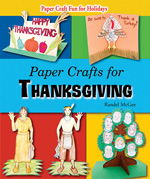 Young readers will enjoy this book filled with all sorts of paper crafts to celebrate Thanksgiving. Basic information about the holiday is provided while also giving simple instructions designed to keep youngsters busy creating paper projects such as corn and gourd paper chains, a Thanksgiving table greeting, and a pop-up turkey card, among others. The adults in the family who are busy preparing the holiday meal will be glad to have their little ones distracted by these easy-to-do crafts made from paper.
Young readers will enjoy this book filled with all sorts of paper crafts to celebrate Thanksgiving. Basic information about the holiday is provided while also giving simple instructions designed to keep youngsters busy creating paper projects such as corn and gourd paper chains, a Thanksgiving table greeting, and a pop-up turkey card, among others. The adults in the family who are busy preparing the holiday meal will be glad to have their little ones distracted by these easy-to-do crafts made from paper.
- Barbara A. Ward, Washington State University Pullman
Parr, Todd. (2012). The thankful book. Boston: Little Brown.
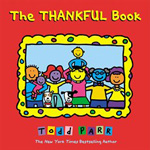 In hot bright colors, Todd Parr has created a book where each page shows how children and other lively characters are thankful for something in their lives. With a loud splash of humor he suggests things like being thankful for underwear so they can wear it on their heads! Or one little girl is thankful for her purple hair because it makes her unique. Other scenarios that kids and characters in the book are grateful for include their gardens, their feet, an elephant is thankful for his ears, bubble baths, and the library that has lots of adventures. This book begs for a read aloud with younger children and the obvious follow-up discussion to share what they are thankful for in their lives. A very fun video introduction by the author is available at the author’s colorful website.
In hot bright colors, Todd Parr has created a book where each page shows how children and other lively characters are thankful for something in their lives. With a loud splash of humor he suggests things like being thankful for underwear so they can wear it on their heads! Or one little girl is thankful for her purple hair because it makes her unique. Other scenarios that kids and characters in the book are grateful for include their gardens, their feet, an elephant is thankful for his ears, bubble baths, and the library that has lots of adventures. This book begs for a read aloud with younger children and the obvious follow-up discussion to share what they are thankful for in their lives. A very fun video introduction by the author is available at the author’s colorful website.
- Karen Hildebrand, Ohio Library and Reading Consultant
Scotton, Rob. (2012). Splat says thank you! New York: Harper.
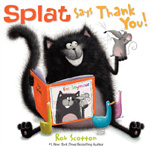 Splat, the cat, and Seymour, the rat, have been friends for a long time. But today Seymour is feeling down, so Splat decides to cheer him. He wants to find a special way to make him feel better so he creates a book, a Friendship Book. It holds many stories about the things the two friends have done together like the time Seymour repaired an ornament that was a favorite of Splat’s mother and Splat thanked him. Or the time Splat’s toe got stuck in the bathtub, it was Seymour that got him unstuck, and Splat said thank you. Rob Scotton’s illustrations are so playful that young readers will be totally engaged with the fun and frolic of Splat. This promises to be an enjoyable read aloud with the obvious connection to make Friendship Books in class. Many downloadable extras including a book trailer and activity kit are available at both the author’s website and the publisher’s website.
Splat, the cat, and Seymour, the rat, have been friends for a long time. But today Seymour is feeling down, so Splat decides to cheer him. He wants to find a special way to make him feel better so he creates a book, a Friendship Book. It holds many stories about the things the two friends have done together like the time Seymour repaired an ornament that was a favorite of Splat’s mother and Splat thanked him. Or the time Splat’s toe got stuck in the bathtub, it was Seymour that got him unstuck, and Splat said thank you. Rob Scotton’s illustrations are so playful that young readers will be totally engaged with the fun and frolic of Splat. This promises to be an enjoyable read aloud with the obvious connection to make Friendship Books in class. Many downloadable extras including a book trailer and activity kit are available at both the author’s website and the publisher’s website.
- Karen Hildebrand, Ohio Library and Reading Consultant
Wilson, Karma. (2012). Bear says thanks. Illus. by Jane Chapman. New York: Margaret K. McElderry Books/Simon & Schuster.
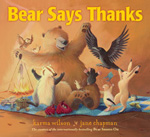 This is the newest companion in Karma Wilson’s lovable bear stories (Bear Snores On, 2002; Bear Wants More, 2003). All of Bear’s forest friends are in the mix again and Bear is trying to find a way to say thank you to all of them for their friendship. He decides to have a dinner party but when he looks at his cupboards they are empty. His friends start to appear at his door each bringing a delectable dish to share. Hare brings muffins and Badger brings fish, and Gopher and Mole and Mouse, Owl, Raven, and Wren all bring food to add to the feast. Bear is feeling badly that he has nothing to contribute but his friends assure him that his stories are the best contribution of all. Jane Chapman has created illustrations that vibrate with fall colors that add to the warm glow of friendship that wraps around each creature, as it will for young readers as well. Visit the author’s website for more about her Bear books and downloadable extras to use in the classroom.
This is the newest companion in Karma Wilson’s lovable bear stories (Bear Snores On, 2002; Bear Wants More, 2003). All of Bear’s forest friends are in the mix again and Bear is trying to find a way to say thank you to all of them for their friendship. He decides to have a dinner party but when he looks at his cupboards they are empty. His friends start to appear at his door each bringing a delectable dish to share. Hare brings muffins and Badger brings fish, and Gopher and Mole and Mouse, Owl, Raven, and Wren all bring food to add to the feast. Bear is feeling badly that he has nothing to contribute but his friends assure him that his stories are the best contribution of all. Jane Chapman has created illustrations that vibrate with fall colors that add to the warm glow of friendship that wraps around each creature, as it will for young readers as well. Visit the author’s website for more about her Bear books and downloadable extras to use in the classroom.
- Karen Hildebrand, Ohio Library and Reading Consultant
GRADES 4-6
Tejubehan. (2012). Drawing from the city. Chennai, India: Tara Books.
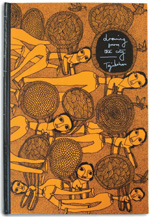 This simple narrative comes from the heart, and every stroke of its illustrations is hand drawn by its narrator. Artist Tejubehan tells her own story of bad luck, poverty, and rising above it. Forced by drought to migrate from their village to Mumbai, her family manages to make a home with whatever they can find. At the age of 16, she marries Ganeshbhai Jogi. Together, they sing traditional songs and serendipitously develop a fondness for drawing when an artist hands them paper and pen. Although Tejubehan is not formally educated, her inner life and reflections of the life around her are rich and evocative. With its gentle narration and arresting images, the book provides the unique perspective of a cultural insider who envisions breaking gender barriers. The author also brings folk art to the forefront of multimodal narration. Tejubehan’s interpretation of her city, its vehicles, and citizens will linger in the hearts and minds of the readers long after the book is closed. Reminding readers what they themselves have to be thankful for, the book is handmade and will stand out in any collection. Readers may be interested in listening to Tejubehan and Ganeshbhai sing at this website.
This simple narrative comes from the heart, and every stroke of its illustrations is hand drawn by its narrator. Artist Tejubehan tells her own story of bad luck, poverty, and rising above it. Forced by drought to migrate from their village to Mumbai, her family manages to make a home with whatever they can find. At the age of 16, she marries Ganeshbhai Jogi. Together, they sing traditional songs and serendipitously develop a fondness for drawing when an artist hands them paper and pen. Although Tejubehan is not formally educated, her inner life and reflections of the life around her are rich and evocative. With its gentle narration and arresting images, the book provides the unique perspective of a cultural insider who envisions breaking gender barriers. The author also brings folk art to the forefront of multimodal narration. Tejubehan’s interpretation of her city, its vehicles, and citizens will linger in the hearts and minds of the readers long after the book is closed. Reminding readers what they themselves have to be thankful for, the book is handmade and will stand out in any collection. Readers may be interested in listening to Tejubehan and Ganeshbhai sing at this website.
- Rani Iyer, Washington State University Pullman
Walsh, Barbara Elizabeth. (2012). The poppy lady: Moina Belle Michael and her tribute to veterans. Illus. by Layne Johnson. Honesdale, PA: Calkins Creek/Boyds Mill Press.
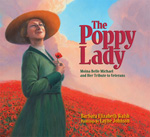 Moina Belle Michael, a teacher at the University of Georgia’s Normal School in 1917, truly lived the phrase “on behalf of a grateful nation” as she devoted her adult life to finding a way to aid and honor veterans. Moina was teaching when World War I broke out and eventually American soldiers were called to foreign shores. Like many women of this era, she started by rolling bandages and knitting socks. Wanting to do more she moved to New York City and started working with the YMCA organization delivering food, books, and inspiration to soldiers. Like many Americans, she read the newly penned poem, “In Flanders Fields” written by Lt. Colonel John McCrae, Canadian army MD, (1872-1918), and it gave her the idea to sell poppies as a way to support our wounded soldiers when they returned home and thus the tradition got started. Beautiful oil paintings illustrate this very well researched book that Walsh based on family interviews, photos, and letters that are included in the author’s notes at the end of the book. A portion of the proceeds for “The Poppy Lady” go to the National Military Family Association’s Operation Purple which works to help children of the U. S. Military. Paired with Linda Granfield’s picture book of the poem “In Flander’s Fields; the story of the poem by John McCrae” (p2005, c1995) Language Arts and Social Studies teachers could join hands for a thoughtful Veteran’s Day commemoration. Go to the author’s website for extensive back matter including a well-done book trailer and other resources about the actual Poppy Lady, Moina Belle Michael. Visit The Children’s War blog for more on The Poppy Lady. Information and words to McCrae’s famous poem can be found at the Arlington Cemetery website.
Moina Belle Michael, a teacher at the University of Georgia’s Normal School in 1917, truly lived the phrase “on behalf of a grateful nation” as she devoted her adult life to finding a way to aid and honor veterans. Moina was teaching when World War I broke out and eventually American soldiers were called to foreign shores. Like many women of this era, she started by rolling bandages and knitting socks. Wanting to do more she moved to New York City and started working with the YMCA organization delivering food, books, and inspiration to soldiers. Like many Americans, she read the newly penned poem, “In Flanders Fields” written by Lt. Colonel John McCrae, Canadian army MD, (1872-1918), and it gave her the idea to sell poppies as a way to support our wounded soldiers when they returned home and thus the tradition got started. Beautiful oil paintings illustrate this very well researched book that Walsh based on family interviews, photos, and letters that are included in the author’s notes at the end of the book. A portion of the proceeds for “The Poppy Lady” go to the National Military Family Association’s Operation Purple which works to help children of the U. S. Military. Paired with Linda Granfield’s picture book of the poem “In Flander’s Fields; the story of the poem by John McCrae” (p2005, c1995) Language Arts and Social Studies teachers could join hands for a thoughtful Veteran’s Day commemoration. Go to the author’s website for extensive back matter including a well-done book trailer and other resources about the actual Poppy Lady, Moina Belle Michael. Visit The Children’s War blog for more on The Poppy Lady. Information and words to McCrae’s famous poem can be found at the Arlington Cemetery website.
- Karen Hildebrand, Ohio Library and Reading Consultant
GRADES 7-8
Fradin, Judith Bloom, & Fradin, Dennis Brindell. (2012). Stolen into slavery: The true story of Solomon Northrup, free black man. Washington, DC: National Geographic.
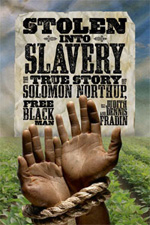 Drawing in part upon the memoirs of Solomon Northrup, a free black man living in New York state prior to the Civil War, the authors craft a true story that will, by turns, trouble and mesmerize readers as they ponder the unexpected dangers and assaults on their liberty that free blacks faced at that time. Northrup, a musician, was lured from his home with the promise of job opportunities, drugged, kidnapped, and then sold as a slave to a series of plantation owners in Louisiana. No one would listen to his insistence that he was a free man. Solomon's story comes to life in the sure hands of the Fradins, who skillfully give readers a peek into his heart and mind as well as describing his heartless kidnappers and the various masters he served during his twelve years of enslavement in Louisiana. As much as slavery as an institution is disturbing, and as harsh as conditions for slaves clearly were during that time, the horrors of having been free in this country and then suddenly losing everything you had, even your name and identity, cannot be denied. Readers are sure to be fascinated by Northrup's story and wonder how he managed to keep up his spirits and never give up hope that he would escape one day. Gratitude and thanks go to Samuel Bass, a carpenter who wrote the letters that enabled Solomon to inform his friends of his whereabouts. Although there are still some questions about some of the events in this fascinating story, they only add to its appeal.
Drawing in part upon the memoirs of Solomon Northrup, a free black man living in New York state prior to the Civil War, the authors craft a true story that will, by turns, trouble and mesmerize readers as they ponder the unexpected dangers and assaults on their liberty that free blacks faced at that time. Northrup, a musician, was lured from his home with the promise of job opportunities, drugged, kidnapped, and then sold as a slave to a series of plantation owners in Louisiana. No one would listen to his insistence that he was a free man. Solomon's story comes to life in the sure hands of the Fradins, who skillfully give readers a peek into his heart and mind as well as describing his heartless kidnappers and the various masters he served during his twelve years of enslavement in Louisiana. As much as slavery as an institution is disturbing, and as harsh as conditions for slaves clearly were during that time, the horrors of having been free in this country and then suddenly losing everything you had, even your name and identity, cannot be denied. Readers are sure to be fascinated by Northrup's story and wonder how he managed to keep up his spirits and never give up hope that he would escape one day. Gratitude and thanks go to Samuel Bass, a carpenter who wrote the letters that enabled Solomon to inform his friends of his whereabouts. Although there are still some questions about some of the events in this fascinating story, they only add to its appeal.
- Barbara A. Ward, Washington State University Pullman
Gregorich, Barbara. (2012). Jack and Larry: Jack Graney and Larry, the Cleveland baseball dog. Chicago: Philbar.
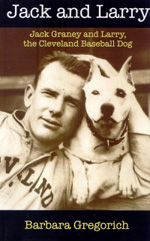 The world of sports has many heroes, and the game of baseball itself can boast plenty of its own celebrated athletes and heroic acts. This brief novel in verse tells the story of courage and inspiration that came in the form of a canine, a bull terrier named Larry, who became the companion of baseball player, Jack Graney, and the mascot for his team, the Cleveland Naps (later, the Indians). Readers will find it hard to resist the emotional tug of this classic tale about the love between a man and a dog as it describes the strong emotional ties between Jack and Larry and eventually between Larry and the also-ran team that just never seems to come up with all the right combinations to win enough games to make it to the World Series, the Holy Grail of professional baseball. The author chooses to include certain details, hint at others, and omit still others. The story begins in 1912 when Jack is unsure if he will remain with his team or be traded. To his delight, he stays with Cleveland, but endures some very tough years with the team. One of the heart-breaking aspects of the book is how the author hints at events that lie ahead. In life, as in baseball, sometimes the ball takes unexpected bounces, and the team must deal with those. Just when things are looking up for Cleveland, tragedy or misfortune seems to strike until finally, amazingly, the team wins the 1920 World Series. Throughout most of those years, Larry captivates the attention of the fans and inspires Jack's teammates. He becomes so famous that he even meets the president of the United States. Above all, though, the book and its two heroes remind us of how persistence and determination sometimes trump sheer ability and talent. Reading this heart-breaking story provides one more reason to be grateful for the blessings of a loyal dog’s companionship and the small acts of heroism that go unnoticed every day.
The world of sports has many heroes, and the game of baseball itself can boast plenty of its own celebrated athletes and heroic acts. This brief novel in verse tells the story of courage and inspiration that came in the form of a canine, a bull terrier named Larry, who became the companion of baseball player, Jack Graney, and the mascot for his team, the Cleveland Naps (later, the Indians). Readers will find it hard to resist the emotional tug of this classic tale about the love between a man and a dog as it describes the strong emotional ties between Jack and Larry and eventually between Larry and the also-ran team that just never seems to come up with all the right combinations to win enough games to make it to the World Series, the Holy Grail of professional baseball. The author chooses to include certain details, hint at others, and omit still others. The story begins in 1912 when Jack is unsure if he will remain with his team or be traded. To his delight, he stays with Cleveland, but endures some very tough years with the team. One of the heart-breaking aspects of the book is how the author hints at events that lie ahead. In life, as in baseball, sometimes the ball takes unexpected bounces, and the team must deal with those. Just when things are looking up for Cleveland, tragedy or misfortune seems to strike until finally, amazingly, the team wins the 1920 World Series. Throughout most of those years, Larry captivates the attention of the fans and inspires Jack's teammates. He becomes so famous that he even meets the president of the United States. Above all, though, the book and its two heroes remind us of how persistence and determination sometimes trump sheer ability and talent. Reading this heart-breaking story provides one more reason to be grateful for the blessings of a loyal dog’s companionship and the small acts of heroism that go unnoticed every day.
- Barbara A. Ward, Washington State University Pullman
GRADES 9-12
Schrefer, Eliot. (2012). Endangered. New York: Scholastic.
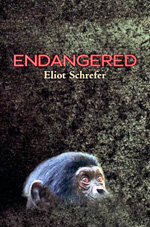 The Congo to which fourteen-year-old Sophie Biyoya-Ciardulli has returned for a summer sojourn with her mother is more annoying and inconvenient than she remembers from when she lived there as a child. Her mother runs a sanctuary there for bonobos, and seems to lavish all her affection on the animals. Sophie is compelled to rescue a bonobo being offered for sale by a man on a bicycle, thus, saving its life, but also breaking one of her mother's rules. Before Sophie can return to her father in Miami, the country erupts in chaos. With her mother away on sanctuary business and most of her mother’s employees slaughtered by renegade soldiers, Sophie and Otto must depend on each other to survive. At first Sophie is able to hide in the sanctuary's enclosure with the other bonobos, but eventually, she must try to reach the capital city or the wilderness where her mother is if the two have any chance to survive. Sophie’s choices will remind teen readers of the strong connections between humans and other animals and the actions each of us may take when our lives or the lives of others are at stake. The author does not shun the violence that fills the countryside, describing the deaths of the sanctuary workers, the violence and cruelty of the boy soldiers who seem to be at the heart of the campaign whose objective is not clear, and the politics at the heart of the conflict. While Sophie is lucky, time and again, to escape relatively unscathed, her resourcefulness, determination and pluckiness are admirable. This is an insightful examination of the value of lives, both humans and bonobos, and how helpless each of us can become in the face of the unexpected. Teen readers will easily slip into Sophie's smelly, almost-rotten sneakers and wonder what they might have done in the same situation, faced with decisions more pressing than what outfit to wear for the day.
The Congo to which fourteen-year-old Sophie Biyoya-Ciardulli has returned for a summer sojourn with her mother is more annoying and inconvenient than she remembers from when she lived there as a child. Her mother runs a sanctuary there for bonobos, and seems to lavish all her affection on the animals. Sophie is compelled to rescue a bonobo being offered for sale by a man on a bicycle, thus, saving its life, but also breaking one of her mother's rules. Before Sophie can return to her father in Miami, the country erupts in chaos. With her mother away on sanctuary business and most of her mother’s employees slaughtered by renegade soldiers, Sophie and Otto must depend on each other to survive. At first Sophie is able to hide in the sanctuary's enclosure with the other bonobos, but eventually, she must try to reach the capital city or the wilderness where her mother is if the two have any chance to survive. Sophie’s choices will remind teen readers of the strong connections between humans and other animals and the actions each of us may take when our lives or the lives of others are at stake. The author does not shun the violence that fills the countryside, describing the deaths of the sanctuary workers, the violence and cruelty of the boy soldiers who seem to be at the heart of the campaign whose objective is not clear, and the politics at the heart of the conflict. While Sophie is lucky, time and again, to escape relatively unscathed, her resourcefulness, determination and pluckiness are admirable. This is an insightful examination of the value of lives, both humans and bonobos, and how helpless each of us can become in the face of the unexpected. Teen readers will easily slip into Sophie's smelly, almost-rotten sneakers and wonder what they might have done in the same situation, faced with decisions more pressing than what outfit to wear for the day.
- Barbara A. Ward, Washington State University Pullman
These reviews are submitted by members of the International Reading Association's Children's Literature and Reading Special Interest Group (CL/R SIG) and are published weekly on Reading Today Online.